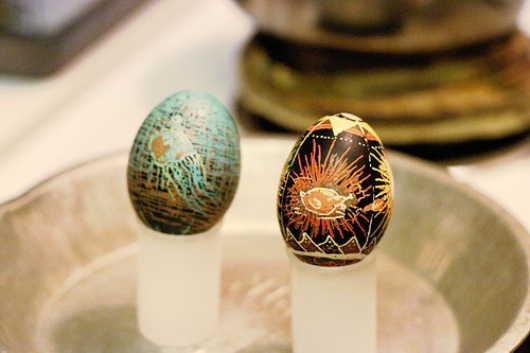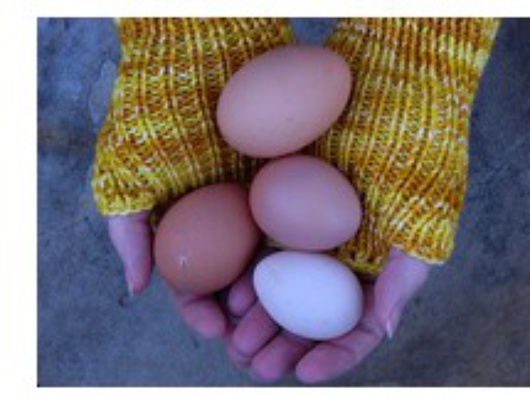
Easter in Europe: all about the egg
Published on
Translation by:
Francesca ReinhardtEverywhere you look, display windows, promotional offers, Easter markets and cards are covered with bright, beautifully decorated Easter eggs
In Poland there are many techniques for painting Easter eggs. The eggs of chickens, ducks, geese and even ostriches are all used for decorating. Hard-boiled eggs are used to make wydmuszki, meaning ‘empty shells’. The remaining Easter eggs are decorated with hot wax, using a piece of wood or a pin, and finally dipped in bright colours. The wax-painted surfaces will not be coloured, so when the wax is removed, an artistic white pattern remains. ‘Slightly modified, this technique can be a creative activity for kids,’ says a staff member at the education department of the Ethnographic Museum in Warsaw. ‘The hot wax can be dangerous for kids, but they can also use wax crayons instead.’
 So-called kraszanki are made quite differently. First the eggs are coloured in a dye made from coloured wool or brown onion peelings. Then a delicate pattern is etched on the shells. The technique requires a steady hand and good graphic skills. ‘It takes two hours to make a kraszanki, says a folk artist from Oppeln. Amateurs need even more time.
So-called kraszanki are made quite differently. First the eggs are coloured in a dye made from coloured wool or brown onion peelings. Then a delicate pattern is etched on the shells. The technique requires a steady hand and good graphic skills. ‘It takes two hours to make a kraszanki, says a folk artist from Oppeln. Amateurs need even more time.
(Photo: ©BZedan/ Flickr)
Easter eggs – not just women’s work anymore
Previously egg-painting was the preserve of women. Men were banned from the living rooms when the Easter eggs were being prepared. Now that everyone enjoys more equality, Easter egg workshops are popular with the whole family, and everyone can learn the labour intensive traditional methods, under the watchful eyes of the folk artists. ‘It is a very pleasant and at the same time educational way to spend time with the kids,’ says one young couple, participating in a workshop with their two small children. ‘We get to explore our creative side and the children have the chance to learn a bit about Polish folk art.’ In many Polish households, the tradition of Easter egg decorating is passed from generation to generation. ‘I used to paint Easter eggs with my siblings. Now I make them with my wife and daughter,’ says Marcin, a 30 year old economist.
Folk art 2.0
Today’s artists are not limited to making gifts for their nearest and dearest, but have branched out onto the internet, where one and all can buy their masterpieces of popular artwork. ‘I used to sell my Easter eggs over Allegro, until I founded my own page and web forum. It became apparent that it’s an exciting hobby for many people and gives them a lot of gratification,’ says Anna Gobniak, an artist with an internet presence. ‘My Easter eggs are very colourful, and also quite popular. I have a few regular customers who order every year, because they are unique and make excellent presents. The site gets many visits from people abroad. Last year my eggs flew to the USA, Australia, Austria, France, the Netherlands, and Canada.’
The egg – one of the most enduring symbols across cultures for all that is good. In antiquity it was the symbol of happiness, fertility, well-being and health. The egg often symbolised the rebirth of life in the spring. According to Polish superstition, the discovery of twin egg-yokes brought good luck – and off-spring soon after. The English made talismans from the eggs of older hens, while the Germans were accustomed to swearing by eggs.
 The oldest clay egg, decorated with symbols, dates to 3000 BC, found by archaeologists in the region of Sumerian Mesopotamia. The tradition of painting and decorating eggs comes from Persia, where the New Year is celebrated as the Festival of the Red Egg. Even today, the word ‘cocoon’ in Hungarian means ‘the red egg’, evoking an Easter egg. In Bulgaria, the first Easter egg is always painted red and must not be thrown away until the following Easter. Safely stored for the whole year, it should bring the family good luck and good health. When visiting family and friends, Bulgarians exchange Easter eggs. A similar custom is practiced in the Czech Republic. In Greece, the day for painting Easter eggs is called the Red Day, and falls on Good Friday. In Romania they say that when the Christians stop painting their eggs, the end of the world is nigh!
The oldest clay egg, decorated with symbols, dates to 3000 BC, found by archaeologists in the region of Sumerian Mesopotamia. The tradition of painting and decorating eggs comes from Persia, where the New Year is celebrated as the Festival of the Red Egg. Even today, the word ‘cocoon’ in Hungarian means ‘the red egg’, evoking an Easter egg. In Bulgaria, the first Easter egg is always painted red and must not be thrown away until the following Easter. Safely stored for the whole year, it should bring the family good luck and good health. When visiting family and friends, Bulgarians exchange Easter eggs. A similar custom is practiced in the Czech Republic. In Greece, the day for painting Easter eggs is called the Red Day, and falls on Good Friday. In Romania they say that when the Christians stop painting their eggs, the end of the world is nigh!
In-text photos (©Zormasa/ Flickr), (©BZedan/ Flickr), homepage (©jmurawski/ Flickr), in-box (©madelinetosh/ Flickr)
Translated from Wszystko kręci się wokół jajka



